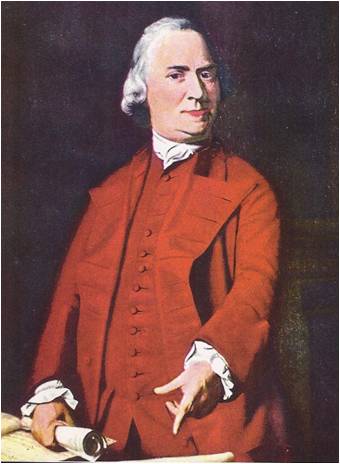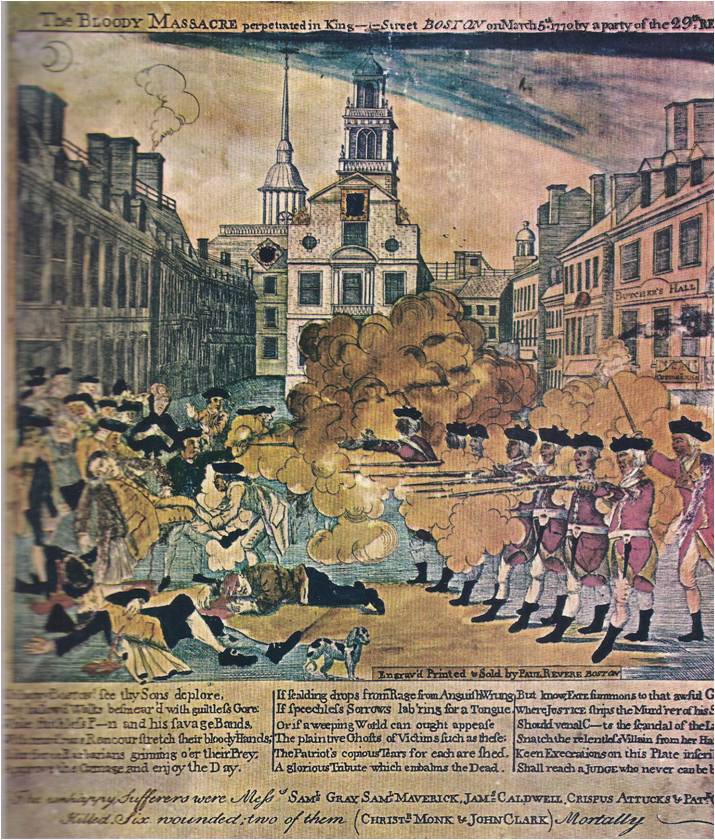EVEN AFTER IT HAPPENED, few people in colonial Boston knew the boy’s name. He was just a barber’s helper, but everyone heard about him on the night of the trouble. On that night he set off an angry mob by pointing his finger at a British guard and the violence that followed became a famous incident in American history. The date was March 5, 1770. Boston was then occupied by British troops. The troops had been brought in to keep order and to force the people to pay taxes they did not want to pay. The people of Boston hated the troops and insulted them at every opportunity. Boys threw snowballs at them and called them “lobsters” because their long red coats were almost the color of boiled lobsters.
On the night of the trouble, the barber’s helper started things off by calling a British officer names. He became so insulting that a British soldier on guard duty nearby finally lost his temper and struck the boy on the head with the butt of his rifle.
News of the attack spread quickly to shops and taverns. Within an hour small bands of men were roving the streets looking for trouble with the hated redcoats. They met a large band of redcoats who were also out looking for trouble.
The badly outnumbered civilians soon took to their heels. To get more people into the streets someone rang a church bell, Boston’s way of sounding the fire alarm.
People who came out of their houses to help fight the fire were told about the boy who had been struck down by a British soldier. That was too much. They searched for the barber’s helper and found him. The boy repeated his story, probably exaggerating to win more sympathy from the crowd. He led them to the sentry box in front of the Customs House and pointing to the soldier on duty there, identified him as the one who had struck the blow.
“Kill him! Kill him!” someone shouted.
The angry crowd rushed at the soldier. He held them off with his bayonet as he backed up the steps of the Customs House, calling for help. A sergeant and six guards came to his aid. They lined up in front of the mob, which by now numbered almost a hundred men and leveled their rifles at them. The sergeant warned the people to stand back, but that only made them more furious. They advanced slowly, daring the soldiers to fire. Some began throwing snowballs stones, sticks — anything they could lay their hands on.
As the mob closed in, a heavy stick hit a soldier named Montgomery. In anger, or by accident, Montgomery fired his rifle into the mob. A man named Crispus Attucks screamed and pitched forward on his face in the snow. In the excitement, other soldiers fired. The stunned crowd stood for a moment in horror, then fell back and scattered, leaving behind them three dead and several seriously wounded.
To prevent further bloodshed, all British soldiers in Boston were removed to Castle William, a fort in the harbour. The redcoats who had done the shooting were given a jury trial. Only two were found guilty and they were let off with light sentences because of the threatening action of the mob.
ADAMS STIRS UP THE PEOPLE
The trial should have ended the matter, but it did not. Samuel Adams and other political leaders of Massachusetts saw to that. They used the incident to stir up the people against England. They called it the Boston Massacre and published exaggerated reports about it. They also sent out thousands of copies of a cartoon by Paul Revere showing a line of British soldiers shooting down peaceful citizens in the street. These political leaders felt that they were doing their patriotic duty by making the Boston Massacre seem worse than it was. They thought people needed a shock to make them realize their liberty was being threatened by the mother country. They wanted to make people angry enough to stand up for their rights in the family quarrel then going on between England and her American colonies.

Chubby little Samuel Adams was doing everything he could to keep the quarrel alive. As a member of the Massachusetts legislature, he spoke out against British rule at every opportunity. He knew there were other colonists who hated the British as much as he did, but very few were doing anything about it. They needed leadership, someone who could bring them together.
In New York, for example, there were many who felt that England had treated them unfairly. Among them were the manufacturers of beaver hats and woolen goods and iron articles. The English Parliament had passed laws which forced all of them out of business because they were taking too many customers away from manufacturers in England.
Many owners of large plantations in the southern colonies also bore a grudge against England. They were deeply in debt to British business firms and blamed their money problems on British trade laws. They had to sell their cotton, tobacco and hides in England at prices which were often unreasonably low and buy their manufactured goods in England at prices that were often very high. They saw themselves as victims of unfair trade laws, which had been forced upon them for the benefit of the mother country.
Most of those who had turned against England had done so after the end of the French and Indian War in 1763. That was the year when the family quarrel between England and her American colonies took a sudden turn for the worse.






